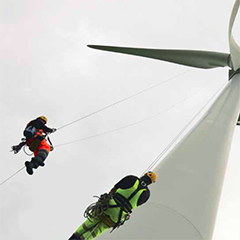PES discovers the Limpet height safety system, with its Intelligent Climb Assist feature, which includes rescue, evacuation and fall arrest. It provides assisted climbs, no matter your weight, saves maintenance time, down times and in the case of an accident – critical time.
“At the top of a wind turbine in France, Gregory, a senior technician accidentally crushed his fingers in a brake pad. In a great deal of pain and with only one working hand, climbing down the twenty story vertical ladder didn’t seem like a good idea. Luckily, Gregory was in a turbine equipped with a Limpet height safety system. Connecting himself to the end of the safety line, he pressed a button on a remote control and was quickly lowered down to the bottom. Under normal circumstances, using standard rescue equipment, getting Gregory down would have taken at least forty minutes. In the event it took only four.”
Stephen Cornwallis, Limpet Technology’s CEO, tells this story with obvious satisfaction. Improving the speed and ease of rescue and evacuation inside wind turbines is a critical application for Limpet. “It’s great when you see your product making a material difference to the outcome of an emergency situation. Most of the time we never get to hear details of accidents, but in this case the owner of the wind farm got in touch to let us know
how pleased he was that he had installed Limpets.”
The rapid growth of the wind energy sector means that thousands of turbines have been installed across Europe, each with significant access and safety challenges for the maintenance engineers that keep them running. Started in 2009, Limpet Technology was founded to develop multifunctional products that would address and solve these problems and the starting point was to focus on the long ladder climbs endured by service technicians and which can result in fatigue, loss of productivity and various health disorders.



























